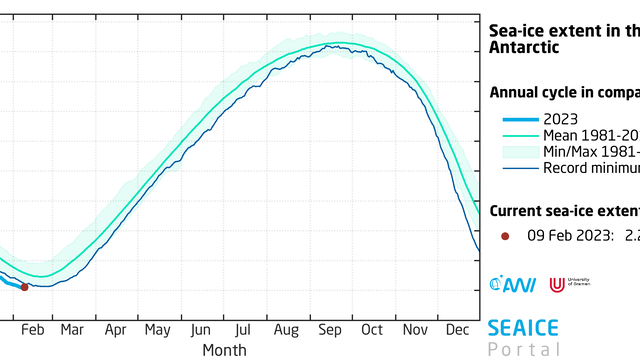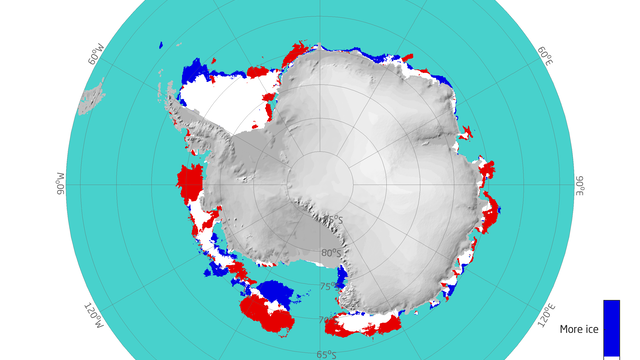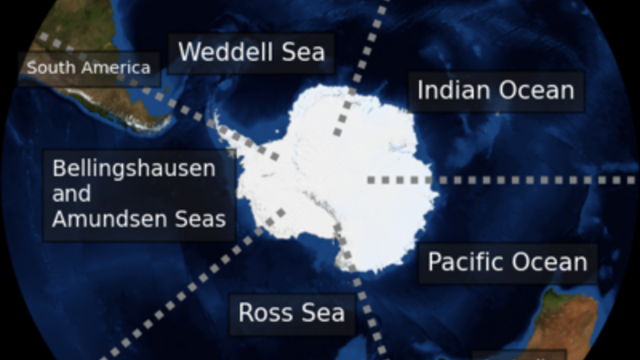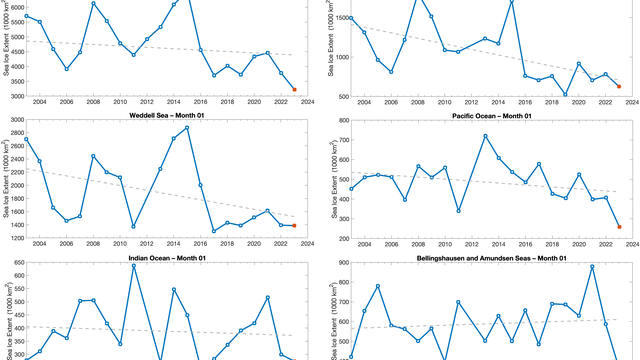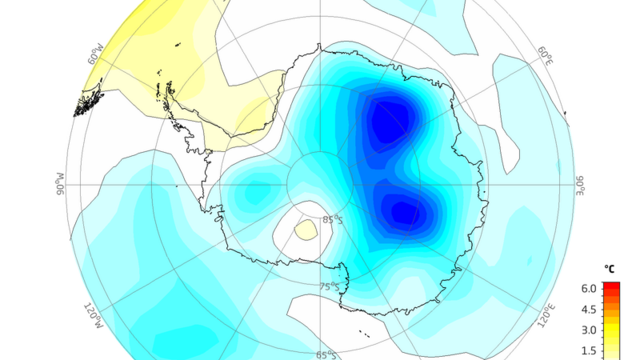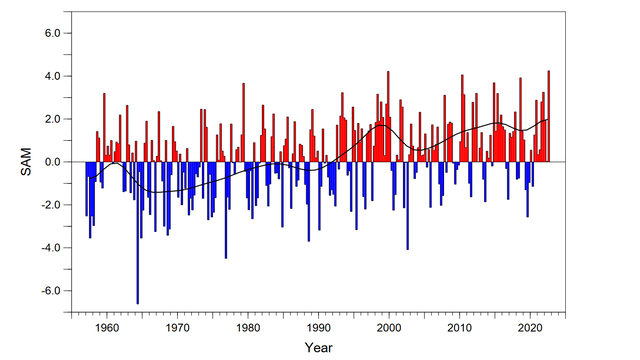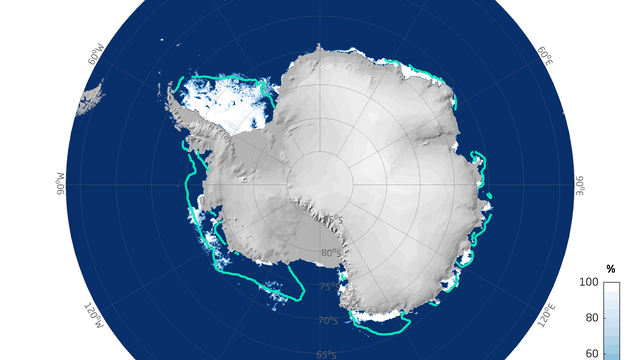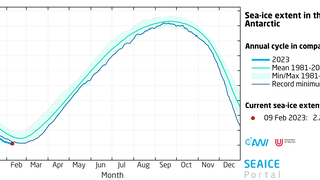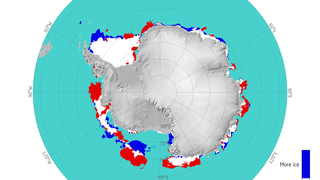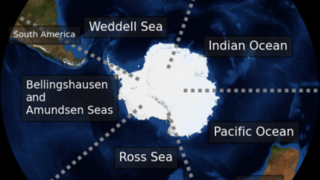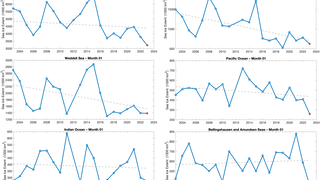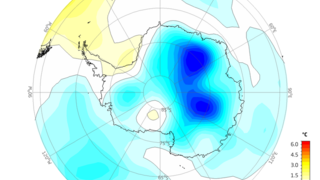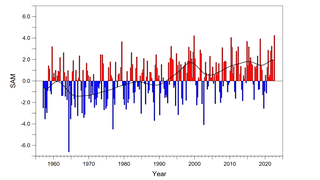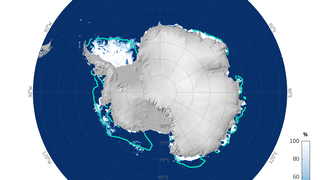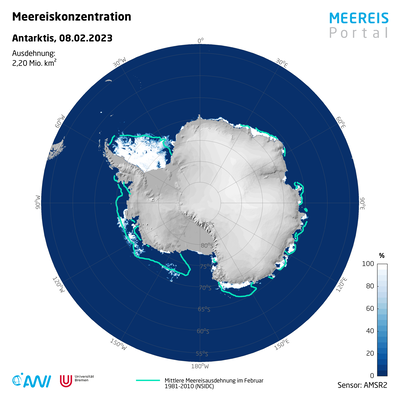“On 8 February 2023, the Antarctic sea-ice extent had reached 2.2 million km² - less than the previous record minimum from 2022. Since the sea-ice melting in the Antarctic will most likely continue in the second half of the month, we can’t say yet when the record low will be reached or how much more sea ice will melt between now and then,” says Prof Christian Haas, head of the sea-ice section at the AWI, summarising the latest developments in the Antarctic. "The rapid decrease in sea-ice over the last six years is very surprising because the ice cover had hardly changed in the previous thirty-five years. It is unclear whether this is the beginning of the rapid end of summer sea ice in Antarctica, or whether it is just a new phase with lower but still stable sea-ice cover in summer."
In the course of the year, the Antarctic sea ice reaches its maximum extent in September or October and its minimum extent in February. In some regions along the coasts of the Antarctic continent, the sea ice melts completely in summer. In winter, the cold water throughout the Antarctic promotes the rapid formation of new sea ice. At its maximum, the sea-ice extent in the Antarctic is generally between 18 and 20 million square kilometres. In summer, it dwindles to roughly 3 million square kilometres, displaying far more natural annual variability than the Arctic.
This year, however, the Antarctic sea ice was already at its lowest recorded extent for the time of year since the beginning of record-keeping (Figure 1 and Figure 2) throughout the entire month of January. The trend began in late December, when the ice reached a new monthly low. The monthly mean value for January 2023 was 3.22 million km², putting it ca. 478,000 km² (Figure 3) below the previous minimum from 2017. In the long term, the Antarctic sea ice shows a declining trend in January, amounting to 2.6% per decade. This is the eighth consecutive year in which the mean sea-ice extent in January has been below the long-term trend, worsening the negative development of the summer sea-ice extent.
Since December, melting has been especially intense in the Bellinghausen and Amundsen Seas, with the former now virtually ice-free (Figure 4). “A record minimum sea-ice cover was also reached in the Pacific sector of the Antarctic (Figures 5 and 6). There is conspicuously little sea ice in the Ross Sea and the Indian Ocean sector, whereas the ice cover in the Weddell Sea is similar to the level in past years, though below the long-term trend. Generally speaking, ice concentrations throughout the Antarctic are below average, continuing the conditions observed in late December 2022,” says Gunnar Spreen from the University of Bremen’s Institute of Environmental Physics (IUP), who helped to analyse the latest satellite data on the current sea-ice situation.
Massive changes could be due to prolonged wind patterns around the Antarctic
This intense melting is due to unusually high air temperatures to the west and east of the Antarctic Peninsula, which were ca. 1.5 °C above the long-term average (see Figure 7). In addition, the Southern Annular Mode (SAM) is in a strongly positive phase, which influences the prevailing wind circulation in the Antarctic. In a positive SAM phase, a low-pressure anomaly forms over the Antarctic, while a high-pressure anomaly develops over the middle latitudes. This intensifies the westerly winds and causes them to coalesce toward the Antarctic. In the middle latitudes (40-50°S), the northern edge of this phenomenon falters. As a result, conditions become drier over Patagonia, while upwelling of circumpolar deep water on the continental shelf intensifies in the Antarctic, promoting sea-ice retreat. This also drives the melting of glaciers and ice sheets.
Effects on the ecosystem
The extent of the sea ice, when it forms, and when it melts are also important aspects for the Antarctic ecosystem, as they determine the production of phytoplankton, which forms the basis for marine food webs. In the Southern Ocean, phytoplankton provides food for tiny shrimplike crustaceans known as krill, which are eaten by larger fauna. Major changes in the timing of phytoplankton blooms can disrupt the feeding patterns of birds, fishes, seals and whales. Sea ice also protects coastal regions from storms by dampening ocean waves.
Complex connections
But determining how all these puzzle pieces influencing the sea ice fit together in the Antarctic continues to pose a considerable challenge. There is still ample cold air in the vicinity of the continent, where the majority of the sea ice is formed before being driven away, making way for the formation of additional ice. But constant northerly winds can push the sea ice into warmer waters, where it melts, reducing the sea-ice extent. When the winds are too weak, the sea ice near the continent stays where it is, leaving little room for new ice to form. The direction the winds blow in, whether they drive the sea ice together or break it up, when the winds blow, and how cold or warm it is – all these factors have significant regional impacts on sea-ice distribution. In the Southern Ocean, openings in the sea ice referred to as polynyas interact with the winds, which play an important part in maintaining circulation for a global ocean current.
Contact
- Dr Gunnar Spreen (Uni Bremen)
- Dr Marcel Nicolaus (AWI
- Prof Christian Haas (AWI)
- Dr Lars Kaleschke (AWI)
- Dr Christian Melsheimer (Uni Bremen)
- Dr Klaus Grosfeld (AWI)
- Dr Renate Treffeisen (AWI)
Questions?
Contact us by E-Mail or use our contact form.
Graphics
